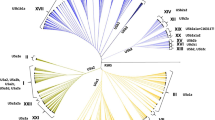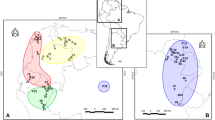Abstract
Genetic structure and phylogeography of the harbour porpoise Phocoena phocoena in the North Pacific were examined using 358 bps sequences from the 5′ end of the mitochondrial DNA control region including those reported previously and newly obtained from the west Pacific. AMOVA and pairwise population φ st estimates clearly revealed genetic differentiation between an east/south and a north/northwest group with the break along the Pacific Rim at British Columbia. In addition, nested clade phylogeographical analysis, neutrality tests, mismatch distribution analysis, genetic diversities and Mantel test, suggested that the observed genetic structure might have been influenced by contiguous range expansion with restricted gene flow in the direction from south to north along the North American coasts and east to west along the Pacific Rim in the middle to late Pleistocene.




Similar content being viewed by others
References
Amano M, Miyazaki N (1992) Geographic variation in skulls of the harbour porpoise, Phocoena phocoena. Mammalia 56:133–144
Avise JC (2000) Phylogeography: the history and formation of species. Harvard University Press, Cambridge
Bickham JW, Patton JC, Loughlin TR (1996) High variability for control-region sequences in a marine mammal: implications for conservation and biogeography of Steller sea lions (Eumetopias jubatus). J Mamm 77:95–108
Bilgmann K, Moller LM, Harcourt RG, Gibbs SE, Beheregaray LB (2007) Genetic differentiation in bottlenose dolphins from South Australia: association with local oceanography and coastal geography. Mar Ecol Prog Ser 341:265–276
Chivers SJ, Dizon AE, Gearin PJ, Robertson KM (2002) Small-scale population structure of eastern North Pacific harbour porpoises (Phocoena phocoena) indicated by molecular genetic analysis. J Cetacean Res Manage 4:111–122
Clement M, Posada D, Crandall KA (2000) TCS: a computer program to estimate gene genealogies. Mol Ecol 9:1657–1659
Crandall KA, Templeton AR (1993) Empirical tests of some predictions from coalescent theory with applications to intraspecific phylogeny reconstruction. Genetics 134:959–969
Excoffier L (2004) Patterns of DNA sequence diversity and genetic structure after a range expansion: lessons from the infinite-island model. Mol Ecol 13:853–864
Excoffier L, Guillaume L, Schneider S (2005) ARLEQUIN, Ver 3.1: An integrated software package for population genetics data analysis. University of Berne, Switzerland. Available from http://cmpg.unibe.ch/software/arlequin3/
Fu YX (1997) Statistical tests of neutrality of mutations against population growth, hitchhiking and background selection. Genetics 147:915–925
Fullard KJ, Early G, Heide-Jorgensen MP, Bloch D, Rosing-Asvid A, Amos W (2000) Population structure of long-finned pilot whales in the North Atlantic: a correlation with sea surface temperature? Mol Ecol 9:949–958
Gaskin DE (1984) The harbour porpoise, Phocoena phocoena (L): regional populations, status and information on direct and indirect catches. Rep Int Whal Comm 34:569–586
Harlin-Cognato A, Bickham JW, Loughlin TR, Honeycutt RL (2006) Glacial refugia and the phylogeography of Steller’s sea lion (Eumatopias jubatus) in the North Pacific. J Evol Biol 19:955–969
Hayano A, Yoshioka M, Tanaka M, Amano M (2004) Population differentiation in the Pacific white-sided dolphin Lagenorhynchus obliquidens inferred from mitochondrial DNA and microsatellite analyses. Zool Sci 21:989–999
Hewitt G (2000) The genetic legacy of quaternary ice ages. Nature 405:907–913
Jefferson TA, Curry BE (1994) A global review of porpoise (Cetacea: Phocoenidae) mortality in gillnets. Biol Conserv 67:167–183
Jørgensen HBH, Hansen MM, Bekkevold D, Ruzzante DE, Loeschcke V (2005) Marine landscapes and population genetic structure of herring (Clupea harengus L.) in the Baltic Sea. Mol Biol 14:3219–3234
Kasuya T, Miyashita T, Kasamatsu F (1988) Segregation of two forms of short-finned pilot whales off the Pacific coast of Japan. Sci Rep Whales Res Inst 39:77–90
Knowles LL, Maddison WP (2002) Statistical phylogeography. Mol Ecol 11:2623–2635
Mantel N (1967) The detection of disease clustering and a generalized regression approach. Cancer Res 27:209–220
McMillan WO, Bermingham E (1996) The phylogeographic pattern of mitochondrial DNA variation in the Dall’s porpoise Phocoenoides dalli. Mol Ecol 5:47–61
Nei M (1987) Molecular evolutionary genetics. Columbia University Press, New York
Nei M, Li WH (1979) Mathematical model for studying genetic variation in terms of restriction endonucleases. Proc Natl Acad Sci USA 76:5269–5273
Palumbi SR (1994) Genetic diversity, reproductive isolation, and marine speciation. Annu Rev Ecol Syst 25:547–572
Panchal M (2007) The automation of nested clade phylogeographic analysis. Bioinformatics 23:509–510
Panchal M, Beaumont MA (2007) The automation and evaluation of nested clade phylogeographic analysis. Evolution 61:1466–1480
Petit RJ (2008) The coup de grace for the nested clade phylogeographic analysis? Mol Ecol 17:516–518
Pichler FB, Robineau D, Goodall RNP, Meyer MA, Olivarria C, Baker CS (2001) Origin and radiation of southern hemisphere coastal dolphins (genus Cephalorhynchus). Mol Ecol 10:2215–2223
Posada D, Crandall KA, Templeton AR (2000) GeoDis: a program for the cladistic nested analysis of the geographical distribution of genetic haplotypes. Mol Ecol 9:487–488
Ramos-Onsins SE, Rozas J (2002) Statistical properties of new neutrality tests against population growth. Mol Biol Evol 19:2092–2100
Ream RR, Sterling JT, Loughlin TR (2005) Oceanographic features related to northern fur seal migratory movements. Deep-Sea Res Pt II 52:823–843
Rogers AR, Harpending H (1992) Population growth makes waves in the distribution of pairwise genetic differences. Mol Biol Evol 9:552–569
Rohling EJ, Fenton M, Jorissen FJ, Bertrand P, Ganssen G, Caulet JP (1998) Magnitudes of sea-level lowstands of the past 500, 000 years. Nature 394:162–165
Rosel PE, Dizon AE, Haygood MG (1995) Variability of the mitochondrial control region in populations of the harbor porpoise, Phocoena phocoena, on interoceanic and regional scales. Can J Fish Aquat 52:1210–1219
Rosel PE, France SC, Wang JY, Kocher TD (1999a) Genetic structure of harbour porpoise Phocoena phocoena populations in the northwest Atlantic based on mitochondrial and nuclear markers. Mol Ecol 8:41–54
Rosel PE, Tiedemann R, Wlaton M (1999b) Genetic evidence for limited trans-Atlantic movements of the harbor porpoise Phocoena phocoena. Mar Biol 133:583–591
Rozas J, Sanchez-DelBarrio JC, Messeguer X, Rozas R (2003) DnaSP, DNA polymorphism analyses by the coalescent and other methods. Bioinformatics 19:2496–2497
Ryder JM, Fulton RJ, Clague JJ (1991) The cordilleran ice sheet and the glacial geomorphology of southern and central British Columbia. Geogr Phys Quatern 45:365–377
Schneider S, Excoffier L (1999) Estimation of past demographic parameters from the distribution of pairwise differences when the mutation rates vary among sites: application to mitochondrial human DNA. Genetics 152:1079–1089
Tajima F (1989) Statistical methods for testing the neutral mutation hypothesis by DNA polymorphism. Genetics 123:585–595
Tamura K, Nei M (1993) Estimation of the number of nucleotide substitutions in the control region of mitochondrial DNA in humans and chimpanzees. Mol Biol Ecol 10:512–526
Templeton AR (2004) Statistical phylogeography: methods of evaluating and minimizing inference errors. Mol Ecol 13:789–809
Templeton AE (2008) Nested clade analysis: an extensively validated method for strong phylogeographic inference. Mol Ecol 17:1877–1880
Templeton AR, Sing CF (1993) A cladistic analysis of phenotypic associations with haplotypes inferred from restriction endonuclease mapping. IV. Nested analyses with cladogram uncertainty and recombination. Genetics 134:659–669
Tolley KA, Rosel PE (2006) Population structure and historical demography of eastern North Atlantic harbour porpoises inferred through mtDNA sequences. Mar Ecol Prog Ser 327:297–308
Tolley KA, Vikingsson GA, Rosel PE (2001) Mitochondrial DNA sequence variation and phylogeographic patterns in harbour porpoises (Phocoena phocoena) from the North Atlantic. Conserv Genetic 2:349–361
Westlake RL, O’Corry-crowe GM (2002) Macrogeographic structure and patterns of genetic diversity in harbor seals (Phoca vitulina) from Alaska to Japan. J Mamm 83:1111–1126
Acknowledgments
We thank Reusch TBH and three anonymous reviewers for their helpful comments on the manuscript. We are grateful to all the fishermen, researchers, volunteers, and institutes that contributed to the collection of the samples used in present study, with special thanks to the staffs at Otaru Aquarium, Hokkaido, and Kamogawa Seaworld, Chiba, and Drs Hajime Ishikawa, the Institute of Cetacean Research, Tokyo, Shinsuke Tanabe, Ehime University, Ehime, and Tadasu K. Yamada, the National Science Museum, Tokyo. We would also like to thank Drs Luis A. Pastene, the Institute of Cetacean Research, Tokyo and Noriko Azuma, Hokkaido University, Hokkaido, for their constructive comments. This work was partly supported by the Sasagawa Scientific Research Grant from the Japan Science Society.
Author information
Authors and Affiliations
Corresponding author
Additional information
Communicated by T. Reusch.
Electronic supplementary material
Below is the link to the electronic supplementary material.
Rights and permissions
About this article
Cite this article
Taguchi, M., Chivers, S.J., Rosel, P.E. et al. Mitochondrial DNA phylogeography of the harbour porpoise Phocoena phocoena in the North Pacific. Mar Biol 157, 1489–1498 (2010). https://doi.org/10.1007/s00227-010-1423-7
Received:
Accepted:
Published:
Issue Date:
DOI: https://doi.org/10.1007/s00227-010-1423-7




